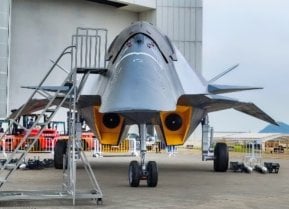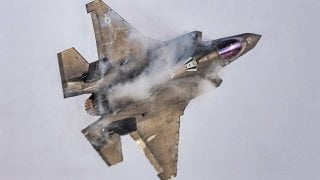Why Does the F-35 Have a Machine Gun?
While the F-35 will ideally engage and destroy adversaries at range with its complement of missiles, it’s always possible that they may end up in a visual engagement in which case Lightning pilots will be very glad to have an internal gun.
Developed with the latest in stealth technology, the F-35 Lightning II represents the pinnacle of fighter development. Boasting the latest in radar cross section (RCS) reducing technologies, advanced electronic warfare suite, and advanced sensor fusion, it is undoubtedly one of the finest tactical aircraft of the day.
One of the unique aspects of the Lightning is its multiple variants. Each of the U.S. services with a tactical air component, the Air Force, Navy, and Marine Corps, have their version of the F-35 suited to their needs. One of the distinctions of the Air Force variant, the F-35A, is the presence of an internal 25mm gun. The strengths of the Lightning and its proposed mission sets have led some to wonder why the Air Force chose to include this weapon.
F-35 Strengths and Missions
The primary differentiator of the F-35 of fourth-generation fighter platforms is the integration of stealth technology. This allows the F-35 to perform air superiority missions at beyond visual range (BVR) shooting down enemy fighters over the horizon. Additionally, it allows them to penetrate enemy air defense zones and attack radar and surface-to-air missile sites.
Uses of a Gun
Guns are the oldest weapons installed in combat aircraft. Initially, they were used to shoot down other aircraft and that is still one of the primary reasons fighters carry a gun today. The other significant use is for ground attack - strafing surface or maritime targets. Some aircraft, such as the A-10 Thunderbolt II, carry large cannons expressly for this purpose.
The F-35 and the Gun
Ultimately, the mission sets requiring a gun are somewhat at odds with an aircraft trying to remain stealthy as their constrained ranges require the pilot to be able to see the target. So why has the Air Force included it in the F-35A?
The decision may be due to lessons learned all the way back in the Vietnam War. During that conflict, the U.S. military flew F-4 Phantom IIs, the latest and greatest aircraft of that era. It included many cutting edge technologies including radar and heat seeking missiles. The wisdom of the era held that guns were no longer needed and so the F-4 did not have an internal gun.
Costly actions over Vietnam where light and agile MiG-21s armed with guns were able to shoot down F-4s, often by getting within the minimum range of the missiles it carried, caused U.S. tacticians to rethink air-to-air combat.
In part, new training was needed for aircrew to ensure they understood how to properly employ air-to-air missiles; however, the gun was reintroduced to the F-4 for those situations where aircrew found themselves in a turning engagement with a hostile fighter.
While the F-35 will ideally engage and destroy adversaries at range with its complement of missiles, it’s always possible that they may end up in a visual engagement in which case Lightning pilots will be very glad to have an internal gun.
About the Author
Maya Carlin, National Security Writer with The National Interest, is an analyst with the Center for Security Policy and a former Anna Sobol Levy Fellow at IDC Herzliya in Israel. She has by-lines in many publications, including The National Interest, Jerusalem Post, and Times of Israel. You can follow her on Twitter: @MayaCarlin. Carlin has over 1,000 articles published over the last several years on various defense issues.
Image Credit: Creative Commons and/or Shutterstock
From the Vault
F-35I Adir: Israel Has a Special Stealth Fighter Even America Doesn't Fly


